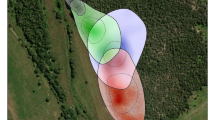Abstract
Territorial songs of 4 Asian Willow Tit subspecies namelyParus montanus kamtschatkensis, P. m. songarus, P. m. affinis andP. m. stoetzneri and in addition those of a southern outpost ofP. m. baicalensis are dealt with. These far-eastern subspecies use song types of their own, but nearly identical types may used by different geographical representatives, which are not closely related. The consequences for reconstructing the evolution of the Willow Tit complex by means of acoustical characters are discussed.
Similar content being viewed by others
Literatur
Bent, A. C. (1946): Life histories of North American jays, crows, and titmice. U. S. Natl. Mus. Bull. 191, XI + 495 S.
Cramp, S., &C. M. Perrins (1993): Handbook of the birds of Europe, the middle East and North Africa. 7: 168–186. Oxford.
Eck, S. (1980): Intraspezifische Evolution bei Graumeisen (Aves, Paridae:Parus, SubgenusPoecile). Zool. Abh. Staatl. Mus. Tierkde. Dresden 36: 135–219.
Ders. (1987): Zum Gesang der Weidenmeise (Parus atricapillus) des Böhmerwaldes (Šumava, ČSSR). Faun. Abh. Staatl. Mus. Tierkde. Dresden 14: 161–162.
Ders. (1990): Alpenmeisen in der ČSR und in Polen. Falke 37: 87–91.
Ders. (1994): Ist die bisherige Systematik der Graumeisen nach über 160 Jahren am Ende? Anz. Ver. Thür. Orn. 2: 109–115.
Ernst, S. (1991): Über den Gesang der WeidenmeiseParus montanus im östlichen Altai. Monticola 6: 178–182.
Ficken, M. S., R. W. Ficken &S. R. Witkin (1978): Vocal repertoire of the Black-capped Chickadee. Auk 95: 34–48.
Gill, F. B., D. H. Funk &B. Silverin (1989): Protein relationships among titmice (Parus). Wilson Bull. 101: 182–197.
Ders.,A. M. Mostrom &A. L. Mack (1993): Speciation in North American chickadees: I. Patterns of mtDNA genetic divergence. Evolution 47: 195–212.
Glutz von Blotzheim, U. N., &K. M. Bauer (1993): Handbuch der Vögel Mitteleuropas 13/I: 419–482. Wiesbaden.
Haffer, J. (1993): Geographische Variation [der Weidenmeise]. In:Glutz von Blotzheim, U. N., &K. M. Bauer, Handbuch der Vögel Mitteleuropas 13/I: 420–423. Wiesbaden.
Hailman, J. P. (1989): The organization of major vocalizations in the Paridae. Wilson Bull. 101: 305–343.
Hudec, K. (1993): Song-types of the Willow Tit (Parus montanus) in the Czech and Slovak Republics. Sylvia 29: 69–71.
Kleinschmidt, O. (1912–1921):Parus salicarius (Kl.). Berajah, 34 S., Halle.
Martens, J., &A. A. Nazarenko (1993): Microevolution of eastern palaearctic Grey tits as indicated by their vocalizations (Parus [Poecile]: Paridae, Aves) I.Parus montanus. Z. zool. Syst. Evolut. forsch. 31: 127–143.
Mayr, E. (1956): Gesang und Systematik. Beitr. Vogelkde. 5: 112–117.
Mundinger, P. C. (1980): Animal cultures and a general theory of cultural evolution. Ethol. Sociobiol. 1: 183–223.
Roselaar, C. S. (1993): Geographical variation [of Willow Tit]. In:Cramp, S., &C. M. Perrins, Handbook of the birds of Europe, the middle East and North Africa. 7: 185–186. Oxford.
Stepanyan, L. S. (1990): Conspectus of the ornithological fauna of the USSR. Moskau.
Stresemann, E., &H. Sachtleben (1920): Über die europäischen Mattkopfmeisen (GruppeParus atricapillus). Verh. Orn. Ges. Bayern 14: 228–269.
Tembrock, G. (1984): Verhalten bei Tieren. N. Brehm-Büch. 178: 139–140. Wittenberg-Lutherstadt.
Thielcke, G. (1973): Uniformierung des Gesangs der Tannenmeise (Parus ater) durch Lernen. J. Orn. 114: 443–454.
Thönen, W. (1962): Stimmgeographische, ökologische und verbreitungsgeschichtliche Studien über die Mönchsmeise (Parus montanus Conrad). Orn. Beob. 59: 101–171.
Ders. (1972):Parus montanus undParus atricapillus: song variation and systematics. Proc. XV. Int. Orn. Congr., The Hague 1970: 696.
Ders. (1993): Verbreitung der drei Gesangsformen vonP. montanus; Entstehungsgeschichte. In:Glutz von Blotzheim, U. N., &K. M. Bauer (1993): Handbuch der Vögel Mitteleuropas 13/I: 423–426. Wiesbaden.
Vaurie, C. (1957): Systematic notes on Palearctic birds. No. 27. Paridae: the generaParus andSylviparus. Amer. Mus. Novit. 1852.
Ders. (1959): Birds of the Palearctic Fauna. Order Passeriformes. London.
Voous, K. H. (1962): Die Vögel Europas und ihre Verbreitung. Berlin.
Ward, R. (1966): Regional variation in the song of the Carolina Chickadee. Living Bird 5: 127–150.
Weigold, H. (1935): Als Ornithologe in Jehol. J. Orn. 83. Sonderheft.
Wolters, E. (1980 [1975–1982]): Die Vogelarten der Erde. Berlin.
Author information
Authors and Affiliations
Rights and permissions
About this article
Cite this article
Martens, J., Ernst, S. & Petri, B. Reviergesänge ostasiatischer WeidenmeisenParus montanus und ihre mikroevolutive Ableitung. J Ornithol 136, 367–388 (1995). https://doi.org/10.1007/BF01651586
Issue Date:
DOI: https://doi.org/10.1007/BF01651586




